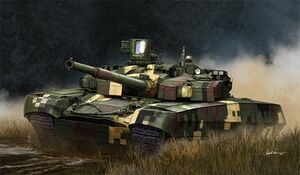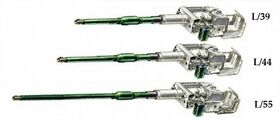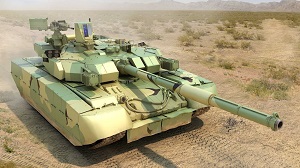YT-3 Crocodile MBT: Difference between revisions
ContraViper (talk | contribs) (→Armor) |
ContraViper (talk | contribs) |
||
| Line 121: | Line 121: | ||
To allow for greater mobility and more versatile gun elevation, an In-arm Suspension Unit (ISU) is used on the YT-3. By allowing for control of each individual control of every bogie on the tracks, the YT-3 is able to adjust suspension & height of different sections of the vehicle. This includes added mobility when moving through rough terrain. | To allow for greater mobility and more versatile gun elevation, an In-arm Suspension Unit (ISU) is used on the YT-3. By allowing for control of each individual control of every bogie on the tracks, the YT-3 is able to adjust suspension & height of different sections of the vehicle. This includes added mobility when moving through rough terrain. | ||
==Electronics== | ==Electronics== | ||
The primary targeting software of the YT-3 Crocodile is the ESQ/GO-22 Electro-Optical Targeting software, a multi-palette electro-optical sensor paired with millimeter wave (MMW) radar that allows for detection and tracking of multiple enemy vehicles at ranges of around | The primary targeting software of the YT-3 Crocodile is the ESQ/GO-22 Electro-Optical Targeting software, a multi-palette electro-optical sensor paired with millimeter wave (MMW) radar that allows for detection and tracking of multiple enemy vehicles at ranges of around 7km. It also comes equipped with a laser range finder on both the main cannon and 14.5mm RWS. | ||
SICA ('''S'''ystèméa D''''I'''ntegration '''C'''ombatte '''Á'''rea) is a net-centric software that allows the tank to receive necessary uplinks from other Inyurstan units operating nearby. An additional {{wp|Identification friend or foe|Identification Friend-or-Foe (IFF)}} is equipped, set to the SACTOCOM-I standard. | SICA ('''S'''ystèméa D''''I'''ntegration '''C'''ombatte '''Á'''rea) is a net-centric software that allows the tank to receive necessary uplinks from other Inyurstan units operating nearby. An additional {{wp|Identification friend or foe|Identification Friend-or-Foe (IFF)}} is equipped, set to the SACTOCOM-I standard. | ||
Revision as of 04:32, 4 September 2023
| YT-3 Crocodile | |
|---|---|
 YT-3 Crocodile MBT on demonstration in Cordoba | |
| Type | Main Battle Tank |
| Place of origin | |
| Service history | |
| In service | 1999 - present |
| Used by | |
| Production history | |
| Designer | Martel Arms |
| Designed | 1991-1997 |
| Unit cost | $Y 9.2mil |
| Produced | 1999 - present |
| Specifications | |
| Weight | 57 tonnes |
| Length | 7.8m (hull) 12m (gun forward) |
| Width | 3.6 m |
| Height | 2.25 m |
| Crew | 3 (Commander, driver, gunner) |
| Armor | Classified composite alloy armor over stainless steel plate along with ERA and NERA modular add-on armor in addition to soft-kill and hard-kill APS systems |
Main armament | Entengo Marauder 120mm Smoothbore |
Secondary armament | Coaxial RK-25 "Shockwave" 25mm Autocannon and RWS-mounted GE-3 14.5mm heavy machine gun |
| Engine | Martel EM820v1 multifuel diesel (Block I) & Martel EM820v2 multifuel diesel-electric hybrid (Block II) 1,450hp |
| Suspension | In-arm suspension |
Operational range | 590 km on internal fuel and energy reserves |
| Speed | Up to 45mph (72km/h) on road, 33mph (53km/h) off-road |
The YT-3 Crocodile is a 3.5th Generation Main Battle Tank produced in Inyursta. Designed to replace Inyursta's aging fleet of Cold War legacy tanks, the YT-3 would go on to see widespread in a number of combat zones. Key features of the YT-3 include a modern smoothbore cannon, composite armor and advanced optical targeting systems.
Development
Conceived in 1991 as the "tank of Inyursta's future", the YT-3 was originally known as TM-70 and was planned as a 3rd Generation main battle tank with room to upgrade - in the case of the later, literal space to install future modular electronics and other forthcoming assets. However, the Crocodile would find itself in "development hell" until the eve of the new millennium.
Previously, in the 1986 Guerrocan War, Inyursta's fleet of mixed-and-matched Cold War tanks had performed poorly, and the need for a new tank was urgent. But this was not exclusive to Inyursta's aging tank fleet. Armored personnel carriers (APCs), artillery, naval ships and aircraft were all falling out of date and in need of upgrades or replacements. The Inyurstan government pushed the Povèra Milleníairé 2000 plan, an attempt to modernize its military with mostly indigenous equipment by the year 2000. Ironically, due to the large success of aerial forces in the 1986 Guerrocan War, new aircraft projects were the first to be approved, followed by infantry transport units (responsible for making great grains across the Guerrocan Arid Savannah) and then artillery, and only then were tanks afforded the privilege of open budgeting.
Martel Arms, in cooperation with Entengo, believed that a 120mm gun (at least) would be a requirement for any modern tank. They marketed their design as a fast, accurate and powerful tank killer; meanwhile PAVCO Arms marketed their rival MBT-1990 concept as a more traditional versatile support vehicle, armed with a traditional 115mm rifled cannon.
Design Features
Armament
The primary armament of the YT-3 Crocodile is the Entengo 120 "Marauder", a 120mm smoothbore cannon. A locally-produced clone of the Rheinmetall_Rh-120, the Crocodile typically uses the L/44 length cannon. A number of projectiles can be carried, including the high-pressure N50A Armor-Piercing Fin-Stabilized Discarding Sabot (APFSDS) series which serves as the primary tank-on-tank ammunition of the Crocodile MBT. Others, such as the N70E1 Airburst Anti-Personnel (AAP), N49N2 High-Explosive Squash Head (HESH) for use against buildings and lighter vehicles, N62E1 SONIC guided anti-tank shell for stand-off attacks, are also often carried. Further, the YT-3 is compatible with most NATO 120mm ammunition such as the M829. 42 rounds of ammunition are stored below the turret.
Secondary armament includes a coaxial 25mm autocannon, the RK-25 "Shockwave", for engaging lightly armored vehicles and infantry positions. Typically 100 rounds of 25mm are carried, though additional ammo is often stored externally. A topside 14.5mm machine is mounted atop the turret. Block I models had this gun manned by the commander's position; however, following the Block II upgrade and production standard from 2010-2016 all manned guns were replaced with remote weapons systems (RWS) controlled from the safety of inside the tank while allowing enhanced imaging options to aim the gun.
Armor
Classified composite alloys form the backbone of the YT-3's base armor. While their composition is unknown, at least two separate material mixes are known to be used in a spaced armor array. The YT-3 is most protected on the front and sides of the turret, and the frontal glacis where the armor is thickest. Additional modular plates made of steel and syndite are applied to the rear sections of the turret, hull and sides.
Explosive Reactive Armor (ERA) can also be fitted to the vehicle, either across all surfaces or selectively those which are most vulnerable. Since its inception, the YT-3 has been fitted with PEVCOMS ERA, with later models utilizing either PEVCOMS-III or PEVCOMS-IV grade protection. Martel Arms has stated that certain types of foreign ERA can be retrofitted onto the YT-3.
The YT-3 Crocodile comes equipped with a number of active protection systems, including both hardkill and softkill. Current models use the Maelstrom Multi-Range Hardkill APS, a system using both short-range directed-energy ERA and a ballistic projectile to defeat incoming threats a wide variety of distances from the vehicle. The LIRDA Softkill APS uses a directed infrared beam to "dazzle" and confuse the warheads on laser and infrared guided warheads.
Performance
Block I Crocodile main battle tanks run on the Martel EM820v1 multifuel diesel engine, capable of putting out an estimated 1,300hp. Later Block II models use a newer Martel EM820v2 multifuel diesel-electric hybrid version capable of a slightly higher 1,450hp. Output allows for roughly 45mph on roads or paved surfaces, and 33mph on most off-road environments. The later EM820v2 also allows for improved fuel capacity, a primary concern when performing deep offensive advances into enemy territory.
To allow for greater mobility and more versatile gun elevation, an In-arm Suspension Unit (ISU) is used on the YT-3. By allowing for control of each individual control of every bogie on the tracks, the YT-3 is able to adjust suspension & height of different sections of the vehicle. This includes added mobility when moving through rough terrain.
Electronics
The primary targeting software of the YT-3 Crocodile is the ESQ/GO-22 Electro-Optical Targeting software, a multi-palette electro-optical sensor paired with millimeter wave (MMW) radar that allows for detection and tracking of multiple enemy vehicles at ranges of around 7km. It also comes equipped with a laser range finder on both the main cannon and 14.5mm RWS.
SICA (Systèméa D'Integration Combatte Área) is a net-centric software that allows the tank to receive necessary uplinks from other Inyurstan units operating nearby. An additional Identification Friend-or-Foe (IFF) is equipped, set to the SACTOCOM-I standard.
History
The YT-3 would see widespread service in the Lolloh-Ruol Wars. During this conflict, they would be deployed by the hundreds to face down almost tenfold their number in Lollohian service. The majority of enemy armor was comprised of T-72 tanks, of which the YT-3 had distinct advantages in armor, targeting systems and ammo penetration; and in peer-on-peer match-ups against a smaller but ever-present quantity of Lollohian "Gladiator II" 4th tanks, they scored a kill ratio of 3.8-to-1.
In over a decade of service, the YT-3 Crocodile would prove its worth time and time again. General (then Colonel) Antonio DeLoroza became famous for personally commanding a YT-3 when he launched both the 1st and 2nd Inyurstan invasions of Lolloh. See Also:
Users
![]() Inyurstan Army: YT-3M2 (primary MBT), YT-3A4 (Army reserves)
Inyurstan Army: YT-3M2 (primary MBT), YT-3A4 (Army reserves)
![]() Inyurstan Marine Corps:YT-3M2 (primary MBT), YT-3A44 (Marine reserves)
Inyurstan Marine Corps:YT-3M2 (primary MBT), YT-3A44 (Marine reserves)
Tifya - YT-3E
Variants
Block I
YT-3A1: Basic Inyurstan service model produced in 1999.
YT-3A2: Additional ERA & slat armor added prior to deployment in the Lolloh-Ruol Wars
YT-3E: 2005+ Export model including steel in place of classified composites and additional soft-kill systems.
YT-3A4: Reserve model including all the electronics & ERA/APS upgrades of 3M2 variant on the engine/base armor chassis of earlier MA1/MA2 variants.
Block II
YT-3M1: 2010 Upgrade/production standard incorporating improved composite armor, electronics upgrades to allow for incorporation of infrared imaging optical targeting systems and Maelstrom Hard-Kill APS.
YT-3M2: Addition of PEVCOMS-IV improved reactive armor and system integration with the N62E1 SONIC guided shell.
YT-3E-M:" 2015+ Export model featuring earlier composite armor (post de-classification) and PEVCOMS-III ERA.
Block III+
YT-3Z1: Proposed Next-Gen upgrades including either a 139mm ETC cannon or the Mericki 7-Frag (129mm) gun.
YT-3PVF:(Plata Vehiculaire Furtivo) Experimental design incorporating an autoloaded RWS cannon for lower profile, heat signature reduction and radar-absorbent armor coating.

